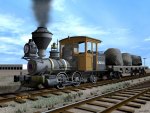The locomotive was built in 1882 by the Baldwin Locomotive Works (BLW) in Philadelphia, PA and began service with the Thomas Hobron's Kahului Railroad Company (formely known as the Kahului & Wailuku Railroad) as Locomotive Number 2 "Claus Spreckels". Locomotive Number 1 "Kalakaua" at that time was a BLW engine of the same type. It replaced the original Number 1 "Queen Emma" which was built in 1878 by Ransomes and Rapier in Ipswich, England.
In February 1884, "Claus Spreckels" pulling a load of nine cars had just approached the Wailuku depot (located just East of the present day intersection of Lower Main and Mill streets) and had uncoupled the last seven cars for unloading while it went ahead to the depot. The brakes on the uncoupled cars failed and the seven cars began to roll down the grade back towards Kahului. Frantic efforts by the crew to place lumber under the wheels of the cars failed. The engineer attempted to recouple his engine to the cars but failed, only making the situation worse by adding momentum to the rolling cars. The cars collided with "Kalakaua" pulling five cars loaded with wood as it rounded the bend (present day intersection of Lower Main and Kahului Beach Road) near the beach. The last car that collided with "Kalakaua" was carrying seven passengers, of which three were killed and the others severely injured.
Five months after the tragic accident, Hobron sold his railroad to Samuel Wilder who also owned the Hawaiian Railroad Company in Mahukona on the big island. His locomotive 1 "Kinau" in Mahukona was a larger engine than Kahului's Number 1 and 2 engines and had problems negotiating the curves there. He therefore swapped Kahului's Number 1 "Kalakaua" for Hawaiian's Number 1 "Kinau". After the swap, "Claus Spreckels" became Number 1 and "Kinau" became Number 2. In Mahukona, "Kalakaua" was renamed "Leslie" and became Number 1.
In 1899, Kahului Railroad Company's largest customer Hawaiian Commercial & Sugar Company now controlled by J.B. Castle & Associates bought the railroad from the Wilder company.
By 1910 "Claus" had undergone many changes. Originally a coal burner, it was converted to a more convenient oil. Its boiler and running gear were replaced a few times. Link and pin couplers were replaced with automatic couplers.
"Claus" and a late 1800's passenger car are currently on display in the dining area of the Maui Tropical Plantation in Waikapu under a long-term agreement with the Alexander & Baldwin Sugar Museum in Puunene.
References
- Best, "Railroads of Hawaii", Golden West Books, Pages 16-20
- Conde, "Narrow Gauge in a Kingdom", Glenwood Publishers, Pages 47-49
- Conde and Best, "Sugar Trains", Glenwood Publishers, Page 225
|
